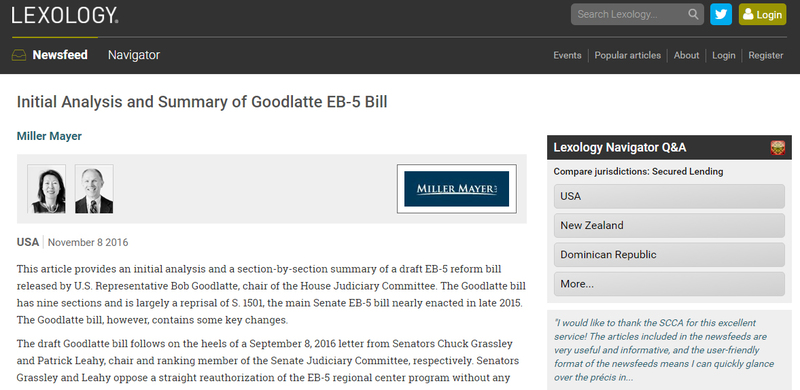This article provides an initial analysis and a section-by-section summary of a draft EB-5 reform bill released by U.S. Representative Bob Goodlatte, chair of the House Judiciary Committee. The Goodlatte bill has nine sections and is largely a reprisal of S. 1501, the main Senate EB-5 bill nearly enacted in late 2015. The Goodlatte bill, however, contains some key changes.
The draft Goodlatte bill follows on the heels of a September 8, 2016 letter from Senators Chuck Grassley and Patrick Leahy, chair and ranking member of the Senate Judiciary Committee, respectively. Senators Grassley and Leahy oppose a straight reauthorization of the EB-5 regional center program without any changes. According to the letter, the EB-5 regional center program “has become plagued with fraud and abuse, and if not reformed it should be allowed to expire on September 30th.” In light of the Grassley-Leahy letter, industry unity on regional center oversight measures will be essential to avoid program lapse after September 30.
The draft Goodlatte bill represents one effort to substantially reform the EB-5 regional center program.
Key highlights include:
A five-year reauthorization of the EB-5 regional center program, until September 30, 2021.
Regional center oversight measures are at Section 3, “Reauthorization and Reform of the Regional Center Program,” mostly reproducing S. 1501’s oversight provisions. This section contains familiar extensive annual reporting requirements, securities law compliance certifications, background checks, project preapprovals, and sanctions. Section 3 also has a new section on account transparency calling for a more active role for escrow banks. The same “Integrity Fund” provisions and amounts are reprised, along with a new $2,000 petition fee. These measures address some of the “minimum” reforms referenced in the Grassley-Leahy letter.
Most provisions in section 3 would take effect no later than 90 days after enactment, but many provisions would require regulations or more detailed guidance. As appears in Section 4, the industry may request regulations or other implementing guidance to be promulgated within 180 days after enactment. Further study is recommended to determine the practical impact of a 90-day effective date for Section 3 if some or all of these provisions will take effect ahead of other statutory changes.
Section 2 puts revocations, denials, and debarments for national security threats and fraud front and center along with restrictions on investor source of funds.
Section 4 of the Goodlatte bill contains many provisions, including:
$1.2 million new threshold investment level for non-TEAs; $800,000 for TEAs as well as infrastructure and manufacturing projects
4,000 non-rolling visa set-asides for rural and “priority urban investment” areas to take effect October 1, 2016
DHS will determine TEAs as well as designate infrastructure and manufacturing projects
TEAs comprise of rural, priority urban investment, closed military bases, and high poverty areas
Redesignation permitted to new TEA (may intend to include redesignation into set-asides)
Effective upon enactment, with exception for pre-6/1/15 petitions. TEA rulemaking required within 180 days of enactment
Retroactive application of the new law is generally contemplated for petitions filed after June 1, 2015. There is limited grandfathering of petitions associated with exemplars filed before June 1, 2015 or approved before enactment. There is no provision for amending petitions to conform to the new law other than for TEA redesignations. Effective date provisions vary section to section. The dominant formula is an effective date any time within 90 days after enactment, with grandfathering for pre-6/1/15 petitions. Petitions filed from 6/1/15 to enactment will also be grandfathered if associated with an exemplar filed before 6/1/15 or approved before enactment.
Direct jobs minimum of 10% remains with modifications in Section 3 and should be reviewed along with the definition of “full-time employment” in Section 4. Notably, though drafting is unclear, construction jobs appear to be deemed direct jobs.
Investor fraud protections remain largely the same and are in the proposed new subparagraph (O) in Section 3. Investors would have 180 days after a regional center is terminated or debarred to associate the new commercial enterprise (NCE) with a new regional center or to invest in a new NCE. There is no tolling in the event a regional center seeks appeals termination and no priority date retention. The Goodlatte bill may contain inadvertent omissions in drafting that may have contemplated additional amelioration.
Site visit references appear in disparate provisions and are required under Section 3. The bill adds a new requirement to review evidence of direct jobs. The effective date requires closer review but appears to be no later than two years after enactment per Section 5.
Beneficial provisions in the draft Goodlatte bill include:
Premium processing regulations within 180 days and “timely processing” goals at Section 7
Mandatory preapprovals but I-526 petitions may be filed upon preapproval filing (as opposed to after approval) at Section 3
Concurrent adjustment applications with visa availability at Section 4
New and notably, investors must be at least 18 under the new law, effective prospectively after enactment per Section 6.
http://www.lexology.com/library/detail.aspx?g=90f79a5d-edd0-40ef-a555-5540a4454622
Mentions
States
- New York
Securities Disclaimer
This website is for informational purposes only and does not constitute an offer or solicitation to sell shares or securities. Any such offer or solicitation will be made only by means of an investment's confidential Offering Memorandum and in accordance with the terms of all applicable securities and other laws. This website does not constitute or form part of, and should not be construed as, any offer for sale or subscription of, or any invitation to offer to buy or subscribe for, any securities, nor should it or any part of it form the basis of, or be relied on in any connection with, any contract or commitment whatsoever. EB5Projects.com LLC and its affiliates expressly disclaim any and all responsibility for any direct or consequential loss or damage of any kind whatsoever arising directly or indirectly from: (i) reliance on any information contained in the website, (ii) any error, omission or inaccuracy in any such information or (iii) any action resulting therefrom.




